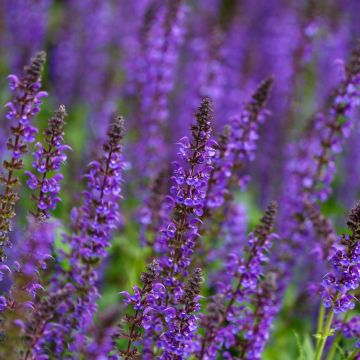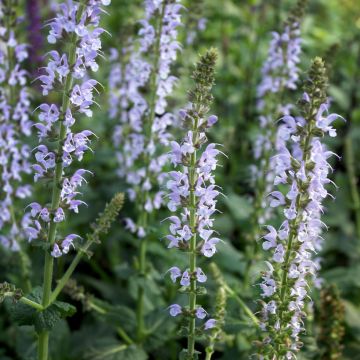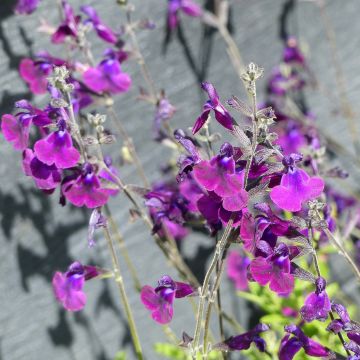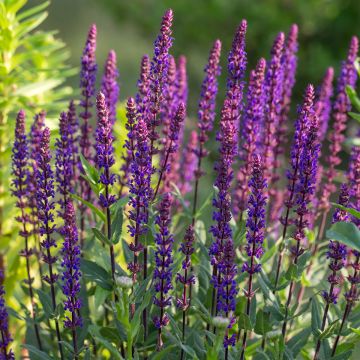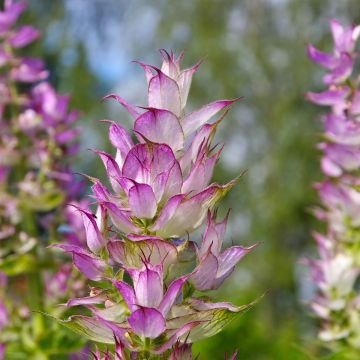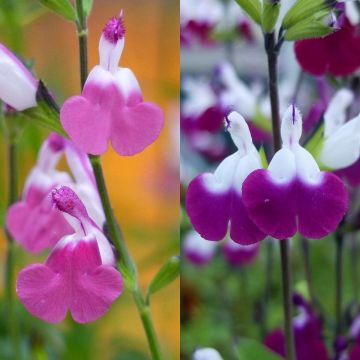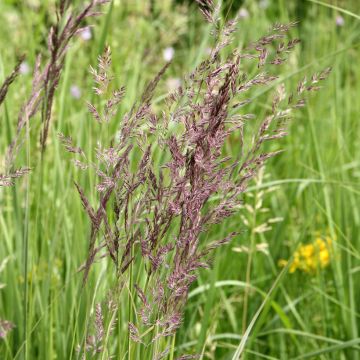

Salvia jamensis La Luna
Salvia jamensis La Luna
Salvia (x) jamensis La Luna
Sage 'La Luna'
Special offer!
Receive a €20 voucher for any order over €90 (excluding delivery costs, credit notes, and plastic-free options)!
1- Add your favorite plants to your cart.
2- Once you have reached €90, confirm your order (you can even choose the delivery date!).
3- As soon as your order is shipped, you will receive an email containing your voucher code, valid for 3 months (90 days).
Your voucher is unique and can only be used once, for any order with a minimum value of €20, excluding delivery costs.
Can be combined with other current offers, non-divisible and non-refundable.
Why not try an alternative variety in stock?
View all →This plant carries a 12 months recovery warranty
More information
We guarantee the quality of our plants for a full growing cycle, and will replace at our expense any plant that fails to recover under normal climatic and planting conditions.
Would this plant suit my garden?
Set up your Plantfit profile →
Description
Salvia x jamensis 'La Luna' is a variety of shrubby sage that charms with its pale-yellow flowering, which is a rather rare colour in this group of salvias. The plant forms a small flexible bush. It blooms for months, with a summer break in between (depending on the climate). Its evergreen foliage releases a pronounced tangy scent at the slightest touch. This drought-resistant variety is relatively hardy. It only requires very well-drained soil, and a sunny or semi-shaded exposure to thrive.
Salvia x jamensis 'La Luna' is a horticultural selection. It comes from a natural hybrid of S. greggii and S. microphylla, which is frequently found in the mountains of Mexico. Like all sages, 'La Luna' belongs to the Lamiaceae family. This shrubby perennial has a flexible, ramified, rounded habit, almost as wide as it is tall. It will reach approximately 60cm (24in) in all directions, or even more in fertile soil. The nectar-rich and honey-bearing flowering period is long. It begins in May-June, slows down if July and August are dry, resumes in September, and continues until November if cold weather does not put an end to it. The flowers are grouped in spikes at the tips of the stems, above the foliage. They are bilabiate, measuring no more than 2cm (1in) in length, and adorned with a pale-yellow hue. They only live for a day, but will already be replaced the next morning. The evergreen foliage is composed of small oval leaves that are slightly toothed. The medium green leaves are thick, aromatic, and slightly sticky, releasing a strongly tangy essential oil. They measure from 1 to 2cm (1in) in length. This variety is hardy to -10 to -12°C (14 to 10.4°F) in well-drained soil.
The warmer and lower light of autumn enhances the flowering of shrubby salvias, which capture the light through their petals like tiny stained-glass windows. These low-maintenance plants are known for their almost uninterrupted flowering from spring to frost. 'La Luna' pairs well with blue, mauve, or salmon-coloured flower varieties. Its combination with medium-sized grasses or autumn asters is fabulous: choose those that require little, like Aster laevis or A. turbinellus, for example. Gauras, tall sedums (Sedum 'Matrona'), shrubby potentillas, and the blue spikes of caryopteris will create a charming scene with it. Plant it in a large pot on a patio, covering its base with bright blue lobelia.
In Mexico, a delicious tea is prepared with the leaves of this sage, which is called 'mountain myrtle' there.
Flowering
Foliage
Plant habit
Botanical data
Salvia
(x) jamensis
La Luna
Lamiaceae
Sage 'La Luna'
Cultivar or hybrid
Other Salvia - Sage
View all →Planting and care
It can be planted all year round, except during freezing periods. It can withstand temperatures down to -10 to -12°C (14 to 10.4°F) in well-drained soil, enriched with gravel or coarse sand, in a sunny and sheltered position. It can be placed in a sunny or partially shaded exposure. It thrives in light, moist soil that is well-drained. It is also adapted to dry soil, so it is better to forget to water it rather than to have excess moisture. At planting, you can apply a base fertiliser (dried horn or dehydrated blood). Apply mulch when the cold weather approaches, or cover the plant with winter fleece. Watering is beneficial in summer, especially during prolonged droughts.
As for pruning, lightly trim the stems that compromise symmetry. Cut back to 20cm (8in) from the ground after the last strong spring frost (in March-April, depending on the region). Remove faded flowers when possible.
Planting period
Intended location
Care
Planting & care advice
This item has not been reviewed yet - be the first to leave a review about it.
Similar products
Haven't found what you were looking for?
Hardiness is the lowest winter temperature a plant can endure without suffering serious damage or even dying. However, hardiness is affected by location (a sheltered area, such as a patio), protection (winter cover) and soil type (hardiness is improved by well-drained soil).

Photo Sharing Terms & Conditions
In order to encourage gardeners to interact and share their experiences, Promesse de fleurs offers various media enabling content to be uploaded onto its Site - in particular via the ‘Photo sharing’ module.
The User agrees to refrain from:
- Posting any content that is illegal, prejudicial, insulting, racist, inciteful to hatred, revisionist, contrary to public decency, that infringes on privacy or on the privacy rights of third parties, in particular the publicity rights of persons and goods, intellectual property rights, or the right to privacy.
- Submitting content on behalf of a third party;
- Impersonate the identity of a third party and/or publish any personal information about a third party;
In general, the User undertakes to refrain from any unethical behaviour.
All Content (in particular text, comments, files, images, photos, videos, creative works, etc.), which may be subject to property or intellectual property rights, image or other private rights, shall remain the property of the User, subject to the limited rights granted by the terms of the licence granted by Promesse de fleurs as stated below. Users are at liberty to publish or not to publish such Content on the Site, notably via the ‘Photo Sharing’ facility, and accept that this Content shall be made public and freely accessible, notably on the Internet.
Users further acknowledge, undertake to have ,and guarantee that they hold all necessary rights and permissions to publish such material on the Site, in particular with regard to the legislation in force pertaining to any privacy, property, intellectual property, image, or contractual rights, or rights of any other nature. By publishing such Content on the Site, Users acknowledge accepting full liability as publishers of the Content within the meaning of the law, and grant Promesse de fleurs, free of charge, an inclusive, worldwide licence for the said Content for the entire duration of its publication, including all reproduction, representation, up/downloading, displaying, performing, transmission, and storage rights.
Users also grant permission for their name to be linked to the Content and accept that this link may not always be made available.
By engaging in posting material, Users consent to their Content becoming automatically accessible on the Internet, in particular on other sites and/or blogs and/or web pages of the Promesse de fleurs site, including in particular social pages and the Promesse de fleurs catalogue.
Users may secure the removal of entrusted content free of charge by issuing a simple request via our contact form.
The flowering period indicated on our website applies to countries and regions located in USDA zone 8 (France, the United Kingdom, Ireland, the Netherlands, etc.)
It will vary according to where you live:
- In zones 9 to 10 (Italy, Spain, Greece, etc.), flowering will occur about 2 to 4 weeks earlier.
- In zones 6 to 7 (Germany, Poland, Slovenia, and lower mountainous regions), flowering will be delayed by 2 to 3 weeks.
- In zone 5 (Central Europe, Scandinavia), blooming will be delayed by 3 to 5 weeks.
In temperate climates, pruning of spring-flowering shrubs (forsythia, spireas, etc.) should be done just after flowering.
Pruning of summer-flowering shrubs (Indian Lilac, Perovskia, etc.) can be done in winter or spring.
In cold regions as well as with frost-sensitive plants, avoid pruning too early when severe frosts may still occur.
The planting period indicated on our website applies to countries and regions located in USDA zone 8 (France, United Kingdom, Ireland, Netherlands).
It will vary according to where you live:
- In Mediterranean zones (Marseille, Madrid, Milan, etc.), autumn and winter are the best planting periods.
- In continental zones (Strasbourg, Munich, Vienna, etc.), delay planting by 2 to 3 weeks in spring and bring it forward by 2 to 4 weeks in autumn.
- In mountainous regions (the Alps, Pyrenees, Carpathians, etc.), it is best to plant in late spring (May-June) or late summer (August-September).
The harvesting period indicated on our website applies to countries and regions in USDA zone 8 (France, England, Ireland, the Netherlands).
In colder areas (Scandinavia, Poland, Austria...) fruit and vegetable harvests are likely to be delayed by 3-4 weeks.
In warmer areas (Italy, Spain, Greece, etc.), harvesting will probably take place earlier, depending on weather conditions.
The sowing periods indicated on our website apply to countries and regions within USDA Zone 8 (France, UK, Ireland, Netherlands).
In colder areas (Scandinavia, Poland, Austria...), delay any outdoor sowing by 3-4 weeks, or sow under glass.
In warmer climes (Italy, Spain, Greece, etc.), bring outdoor sowing forward by a few weeks.






























